Robust early pregnancy prediction of later preeclampsia using metabolomic biomarkers
- PMID: 20837882
- PMCID: PMC7614124
- DOI: 10.1161/HYPERTENSIONAHA.110.157297
Robust early pregnancy prediction of later preeclampsia using metabolomic biomarkers
Abstract
Preeclampsia is a pregnancy-specific syndrome that causes substantial maternal and fetal morbidity and mortality. The etiology is incompletely understood, and there is no clinically useful screening test. Current metabolomic technologies have allowed the establishment of metabolic signatures of preeclampsia in early pregnancy. Here, a 2-phase discovery/validation metabolic profiling study was performed. In the discovery phase, a nested case-control study was designed, using samples obtained at 15±1 weeks' gestation from 60 women who subsequently developed preeclampsia and 60 controls taking part in the prospective Screening for Pregnancy Endpoints cohort study. Controls were proportionally population matched for age, ethnicity, and body mass index at booking. Plasma samples were analyzed using ultra performance liquid chromatography-mass spectrometry. A multivariate predictive model combining 14 metabolites gave an odds ratio for developing preeclampsia of 36 (95% CI: 12 to 108), with an area under the receiver operator characteristic curve of 0.94. These findings were then validated using an independent case-control study on plasma obtained at 15±1 weeks from 39 women who subsequently developed preeclampsia and 40 similarly matched controls from a participating center in a different country. The same 14 metabolites produced an odds ratio of 23 (95% CI: 7 to 73) with an area under receiver operator characteristic curve of 0.92. The finding of a consistent discriminatory metabolite signature in early pregnancy plasma preceding the onset of preeclampsia offers insight into disease pathogenesis and offers the tantalizing promise of a robust presymptomatic screening test.
Figures


References
-
- Sibai B, Dekker G, Kupferminc M. Pre-eclampsia. Lancet. 2005;365:785–799. - PubMed
-
- Levine RJ, Maynard SE, Qian C, Lim KH, England LJ, Yu KF, Schisterman EF, Thadhani R, Sachs BP, Epstein FH, Sibai BM, et al. Circulating angiogenic factors and the risk of preeclampsia. N Engl J Med. 2004;350:672–683. - PubMed
-
- Redman CW, Sargent IL. Latest advances in understanding preeclampsia. Science. 2005;308:1592–1594. - PubMed
-
- Meads CA, Cnossen JS, Meher S, Juarez-Garcia A, ter Riet G, Duley L, Roberts TE, Mol BW, van der Post JA, Leeflang MM, Barton PM, et al. Methods of prediction and prevention of pre-eclampsia: Systematic reviews of accuracy and effectiveness literature with economic modelling. Health Technol Assess. 2008;12(iii–iv):1–270. - PubMed
Publication types
MeSH terms
Substances
Grants and funding
LinkOut - more resources
Full Text Sources
Other Literature Sources

